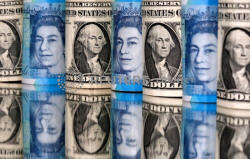Swiss franc falls against euro on Brexit relief, dollar dips on U.S.
stimulus
 Send a link to a friend
Send a link to a friend

[December 28, 2020] By
Yoruk Bahceli
AMSTERDAM (Reuters) - The Swiss franc fell
to its lowest in nearly seven months against the euro on Monday as the
Brexit trade deal remained in focus, while the dollar dipped after U.S.
President Donald Trump signed a COVID-19 aid bill, averting a government
shutdown.
The Swiss franc fell 0.3% to 1.08860 against the euro, its lowest since
June 8. It was unchanged against the U.S. dollar at 88.835 cents at 0903
GMT.
"What we are seeing is a continuation of the pricing out of hard Brexit
risk," said Ulrich Leuchtmann, head of FX research at Commerzbank in
Frankfurt.
"I think a lot of market participants saw Swissie as an alternative to
the euro, (which) would have been harder affected by a hard Brexit," he
said. Investors were likely to close out of such positions in the
following sessions, he added.
The euro was up 0.1% $1.22370, near the 2 1/2-year high of $1.2273
touched this month.

In the United States, Trump signed into law a $2.3 trillion pandemic aid
and spending package, averting a partial federal government shutdown
that would have started on Tuesday.
The dollar dipped 0.3% against a basket of currencies to 90.031, its
lowest in a week.
The boost to risk appetite also hurt safe-haven government bonds, with
10-year U.S. Treasury yields up 2 basis points at 0.95%.. Germany's
benchmark 10-year yield was unchanged at -0.55%.
Meanwhile, Britain's sterling added 0.1% against the U.S. dollar to
$1.3551 , continuing to keep in sight the $1.3625 mark it hit earlier
this month for the first time since May 2018.
It neared that level on Thursday, when Britain and the EU announced the
trade deal.
The pound was down 0.5% against the euro at 90.280 pence.
"Markets are likely to wait until next week though before buying
(sterling) again, fearful of massive bottlenecks at the English Channel
as the new rules take effect," Jeffrey Haley, senior market analyst at
OANDA told clients.
[to top of second column] |

Pound and U.S. dollar
bills are seen in this illustration taken January 6, 2020.
REUTERS/Dado Ruvic/Illustration

While the deal came as a relief to investors, the bare-bones nature of
the pact leaves Britain far more detached from the EU, analysts say,
suggesting any subsequent gains will be modest and the discount that has
dogged UK assets since 2016 will not vanish soon.
Brussels has made no decision yet on whether to grant Britain access to
the bloc's financial market.
Mitsuo Imaizumi, chief FX strategist at Daiwa Securities in Tokyo,
expects the pound and euro to decline against the dollar, reaching $1.30
and $1.15 respectively by the end of the summer.
The Australian dollar, a trade sensitive currency, inched up to 76.110
U.S. cents, toward the 2 1/2-year high of 76.390 reached this month.
Yields on 10-year Southern European bonds - deemed riskier due to their
lower credit ratings - dipped 2-3 basis points.
The yuan crept up after China's central bank lifted its official
guidance level to the highest in 30 months, to as high as 6.5280 against
the dollar in the onshore market, but was last unchanged at 6.5408.
It was last down 0.3% in the offshore market at 6.5311.
The yen rose slightly against the dollar, up 0.1% at 103.455. .
Policymakers at Japan's central were divided on how far they should go
in examining yield curve control with some calling for a comprehensive
review of the framework, a summary of opinions voiced at the December
rate review showed on Monday.

(Reporting by Yoruk Bahceli; additional reporting by Kevin Buckland in
Tokyo; Editing by Andrew Heavens)
[© 2020 Thomson Reuters. All rights
reserved.] Copyright 2020 Reuters. All rights reserved. This material may not be published,
broadcast, rewritten or redistributed.
Thompson Reuters is solely responsible for this content. |